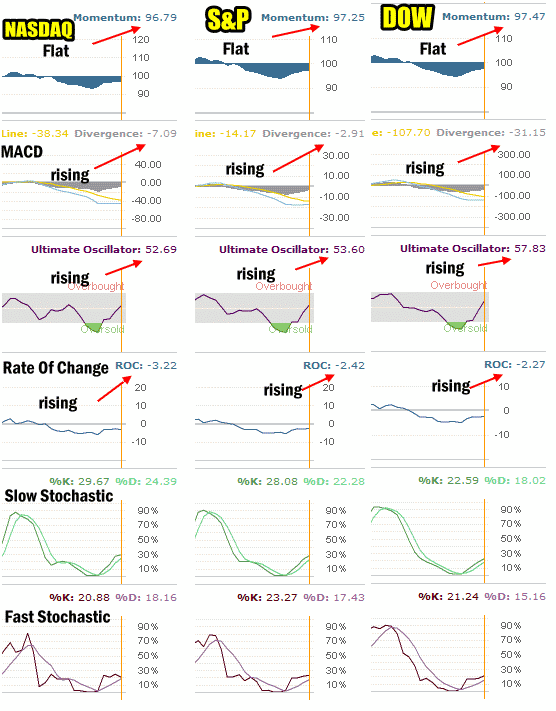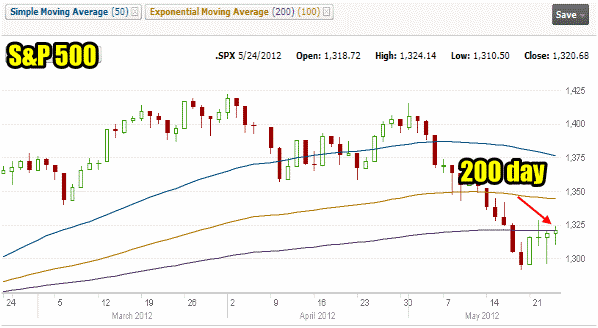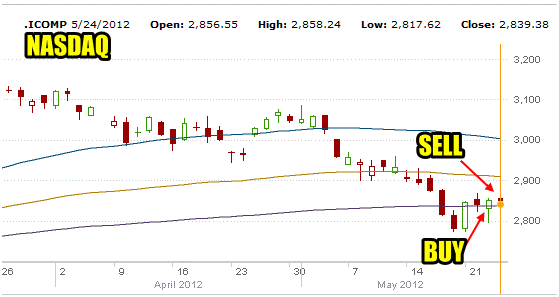Market timing as many readers of fullyinformed.com know is important to my trading strategies. Through market timing I try to predict the market direction so that when I sell puts for do a stock trade, I am on the right side of the market. I do not need market timing to tell me if market direction is going to rush higher, although that would be nice especially for buying SPY Calls. However I do need to know market direction to have confidence when I am placing a trade that the market direction may hold which will increase the odds of the trade being profitable.
To figure out whether there is enough strength in the S&P 500 to allow me to commit additional cash, I used my market timing indicators on the major indexes to determine how strong the market might be at this stage of the correction. I used market timing indicators to read The NASDAQ, The Dow and The S&P 500.
Market Timing For Market Direction
My market timing indicators were quite interesting when I compared the three major indexes. Below you can see the combined chart of The NASDAQ, The S&P 500 and The Dow.
Momentum is flat on all three indexes which would indicate that there remains limited conviction on the part of investors. When the stock markets fall some buying enters but when the market moves up there is little buying.
MACD one of the stronger market timing indicators as it covers both momentum and is an oscillator are showing negative for all 3 indexes but the trend is still rising.
The Ultimate Oscillator is now back above 50.00 on all three indexes which predicts a positive turn in the market or market direction up.
Rate Of Change is still negative on all three indexes but it is climbing.
The last two market timing indicators are quite interesting. Slow Stochastic is predicting that the market direction remains up and as the slow stochastic predicts beyond one or two days, this could be significant.
Fast Stochastic predicts one or two days out and for The NASDAQ it is reasonably flat albeit with a positive bias. For the other two indexes the fast stochastic is indicating that both of these markets should move higher from here.

Market timing indicators on all 3 indexes for May 24 2012
Market Timing Charts
The market timing charts for today on all three indexes are almost identical. All three indices are clinging to the 200 day moving average. Yesterday the candlestick on the S&P 500 was a market up call. Today’s S&P 500 candlestick is a white spinning top. This candlestick shows the indecision among the bulls and bears. The candlestick for today also shows that the market while still at the 200 day, did not close at the high for the day.

The Market Timing Chart For The S&P 500 shows that the index is clinging to the 200 day moving average.
Market Direction Sell Signal On NASDAQ
Yesterday the candlestick on the NASDAQ issued a buy signal. Today however the candlestick issued a sell signal. This shows how indecisive the latest rally was. The NASDAQ candlestick today was a black candlestick which represents selling pressure. For much of the day the NASDAQ index was being pressured. This caused the black candlestick and the reason for the candlestick to issue a sell on the NASDAQ.

Market Timing Candlestick Sell Signal On The NASDAQ
The Dow Index has not issued a buy signal despite the push back to the 200 day moving average and today it did close near the high for the day. But there are many headwinds for these markets to push through to rally back.
Market Timing Outlook For June
As the markets are into their final week of May trading, it is interesting to point out that May has been a poor month for stocks for many years. However June has been a better month and with the elections this year, the market could receive the much-needed elections push to get it back above the 200 day moving average.
My own opinion based on my market timing indicators is that the market direction will try to hold here. If market direction can hold a few days indexes could build enough strength to regain the 100 day moving average and from there the 50 day moving average. However all the European problems and now China’s forecast slowdown could be more than the markets can handle. If that is the case then raising cash will remaining one of the best strategies until the market regains its footing and moves higher.
